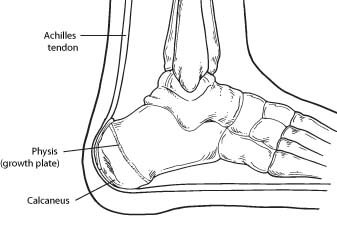While “get well” kisses and hugs may work for little bumps and bruises, it’s important to take foot and heel pain in children seriously. Since children are still developing, an injury to growing tissue could cause complications later down the road.
Additionally, the main causes of foot and heel pain in children is different than in adults. Here, we’ll discuss the common causes of child foot pain, possible treatment and prevention options, and the signs that it’s time to take your child to a podiatrist.
Causes of Heel Pain in Children
The bones in the heel are not fully developed until about age 14, so they are prone to issues and can be easily damaged. If your child is experiencing unexplained heel pain, they should be seen by a podiatrist as quickly as possible. A few causes of foot and heel pain in children include:
Calcaneal Apophysitis
The most common cause of heel pain in children is calcaneal apophysitis. Also called Sever’s disease, this condition occurs when the growth plate (apophysis) of the heel bone (calcaneus) is under too much pressure. This is often due to the heel bearing the weight of the child’s body while it’s being tugged on by the Achilles tendon.

Author: American College of Foot and Ankle Surgeons
Source: https://www.acfas.org/Content.aspx?id=1483
Calcaneal apophysitis can occur in children from ages 5 to 13, especially during a growth spurt.
Symptoms and Treatment Options
Heel pain that is more present during activities such as running and jumping is the main sign of Sever’s disease.
Treatment options usually include:
- Activity modification or rest.
- Heel cord stretching through physical therapy.
- Non-steroidal anti-inflammatory drugs (NSAIDs), such as Ibuprofen, reduce pain and swelling.
- Ice packs to alleviate pain.
- Short-leg cast to relieve pressure on the growth plate in more severe cases.
Since X-rays are often necessary to rule out fractures and other possible causes, you’ll want to take your child to the podiatrist as soon as possible. Luckily, this condition is not permanent and typically lasts 2-3 months. In some cases, the pain can return at any time while the heel bone continues to develop.
Other Causes of Heel Pain
For teenagers, heel pain may be caused by:
- Plantar fasciitis (inflammation of the ligament connecting your toes to your heel).
- Tendonitis or bursitis (inflammation in parts of the heel).
- Bruises to the bone.
- Heel fractures.
These conditions are often caused by sports injuries or activities that put a strain on the heel of the foot.
Treatment Options
Depending on the condition, treatment may be as simple as the RICE strategy and switching to properly-fitted footwear. Other conditions may require the help of a podiatrist and could include surgery or physical therapy.
Causes of Foot Pain in Children
There are numerous causes of foot and ankle pain in children. In most cases, the culprit for foot pain is something that can be corrected or treated very easily.
Causes of foot pain in children include:
- Fallen arches, also known as flat feet. This can occur in children if the arch of the foot develops abnormally. In most cases, there is no pain with this condition, but it can sometimes cause discomfort or feet to roll inwards while walking.
- Sport/Play Injuries. Common injuries like ankle sprains can occur during sports or play when a child changes directions suddenly or takes a fall.
- Ingrown toenails. This is when a toenail grows into the skin, causing pain and inflammation. Ingrown toenails are sometimes caused by incorrect nail trimming or tight-fitting shoes.
- Plantar warts. These are skin growths that can appear on the bottom of the foot. They can be painful, causing a child to limp to avoid putting pressure on the afflicted area.
Child Foot Pain Treatment Options
If your child has flat feet and it makes it more difficult for them to walk or exercise normally, a podiatrist may use custom orthotics (shoe inserts) to support the foot and correct the fallen arch.
Severe ingrown toenails and plantar warts may require surgery as a last resort, but there are alternative treatment options that your podiatrist will discuss with you and your child first.
In some cases, the RICE strategy can help your child quickly recover. In other cases, shoes that fit comfortably and offer arch support can help your children to avoid further injury.
When Your Child May Need a Podiatrist
Since a child’s heel bones are still growing, they should see a podiatrist for any intense foot or heel pain to rule out possible serious injuries and conditions.
You may also need a podiatrist to assess an injury in the foot or ankle if the pain persists in order to prevent further damage and provide pain relief when needed. For example, the podiatrist may recommend ankle strengthening exercises if your child has frequent ankle sprains or has suffered from a severe sprain in the past.
Even if you decide to treat child foot pain at home, you should take your child to see a podiatrist if the pain continues or worsens after 24 hours.
The Foot and Ankle Group Is Here for the Whole Family
With several locations in Southwest Florida, the Foot & Ankle Group is available to provide the best care for you or your child’s feet so your family can feel confident that a solution is right around the corner.
If you have questions about heel pain in children or you’re looking for foot care for your whole family, we’re here to help. Contact us today to schedule an appointment.
Categorized in: Blog
Comments are closed